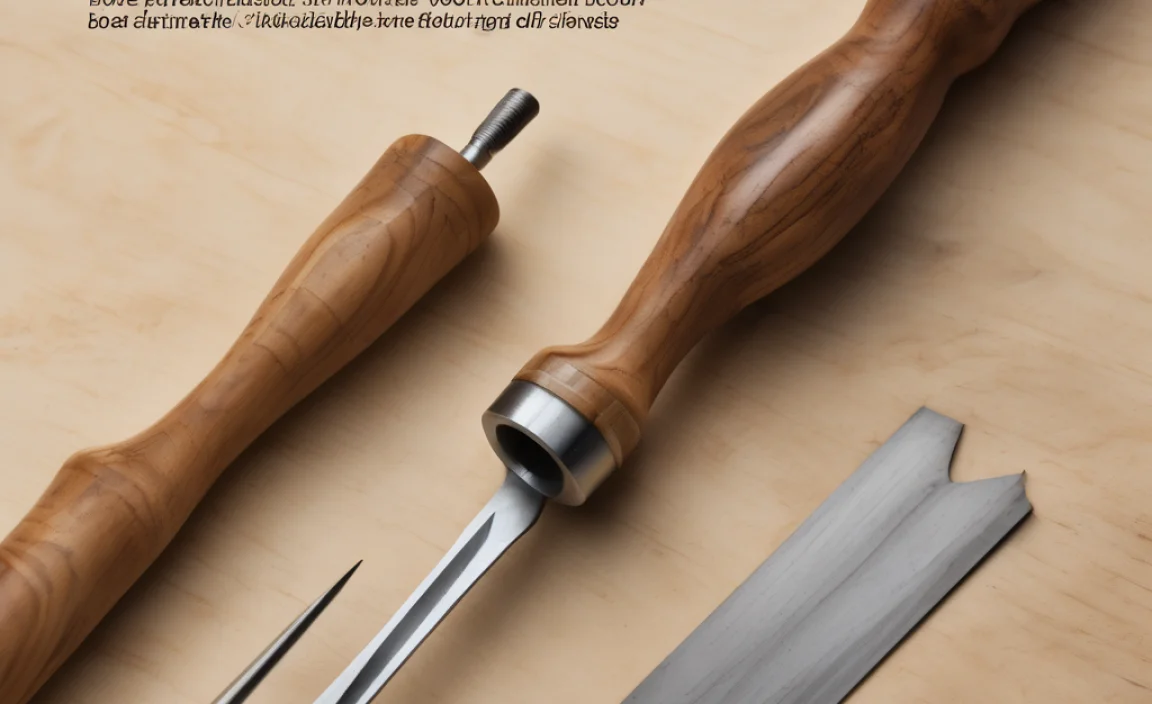The 1/8 inch carbide end mill is a fantastic tool for cutting stainless steel. With the right setup and techniques, you can achieve impressive tool life, saving you time and money. This guide will show you how.
Cutting stainless steel can feel like a puzzle, especially when you’re just starting out. You’ve got this shiny 1/8 inch carbide end mill, ready to go, but stainless steel tends to be tough and sticky. It can quickly dull your tool, leading to frustrating results and wasted money. Don’t worry! With a few key adjustments and practices, you can make that little end mill work wonders and last a long time. We’ll walk through everything you need to know, from choosing the right tool to setting up your machine for success, ensuring you get the best results on your stainless steel projects.
Why Stainless Steel is Tricky (and How a 1/8 Inch Carbide End Mill Helps)
Stainless steel gets its name from its resistance to rust and corrosion, thanks to its chromium content. While great for the final product, this alloying makes it harder and tougher to machine than regular mild steel. It has a tendency to “work harden,” meaning it gets even tougher as you cut into it. This can quickly wear down cutting tools, especially softer ones. That’s where carbide comes in. Carbide end mills are made from a very hard material (tungsten carbide particles bonded together), making them far more resistant to the heat and abrasion generated when cutting tough metals like stainless steel. A 1/8 inch carbide end mill, while small, packs a punch and, when used correctly, can deliver excellent performance and longevity on stainless steel.
Choosing Your 1/8 Inch Carbide End Mill for Stainless Steel
Not all 1/8 inch carbide end mills are created equal, especially when it comes to stainless steel. Here’s what to look for:
End Mill Geometry Matters
- Number of Flutes: For stainless steel, you generally want an end mill with fewer flutes. A 2-flute or 3-flute end mill is often preferred. More flutes can lead to chip packing in tough materials, causing tool breakage. Fewer flutes provide better chip clearance, which is crucial for stainless.
- Helix Angle: A higher helix angle (around 30-45 degrees) helps to shear the material cleanly and evacuate chips effectively. This reduces cutting forces and heat buildup.
- Center Cutting: Ensure your end mill is “center cutting.” This means it can plunge straight down into the material, which is necessary for many milling operations.
- Coating: While not always essential for beginners, coatings like TiCN (Titanium Carbonitride) or AlTiN (Aluminum Titanium Nitride) can significantly improve tool life and performance on stainless steel by increasing hardness and reducing friction.
Material and Shank Size
Always opt for solid carbide. For stainless steel, the material your end mill is made of is as important as its geometry. The 1/8 inch refers to the cutting diameter, and the shank is usually 1/8 inch as well for this common size. Ensure it’s designed for milling metals.
Key Feature for Tool Life: Look for end mills specifically advertised for cutting stainless steel or high-temperature alloys. These are often manufactured with tighter tolerances and superior carbide grades.
Essential Setup Parameters for Success
Getting your machine settings right is paramount for maximizing your 1/8 inch carbide end mill’s life when cutting stainless steel. This involves speed, feed rate, and depth of cut.
Spindle Speed (RPM)
Stainless steel requires slower spindle speeds compared to softer materials like aluminum. A good starting point for a 1/8 inch carbide end mill in stainless steel is typically between 3,000 and 8,000 RPM. The exact speed will depend on your machine’s rigidity, the specific grade of stainless steel, and the depth of your cut. Always consult the end mill manufacturer’s recommendations if available.
Feed Rate
The feed rate is how fast the end mill moves through the material. For stainless steel, you need a relatively aggressive feed rate to prevent the carbide from rubbing and generating excessive heat. Too slow a feed rate will cause the cutting edge to rub rather than cut, rapidly leading to wear and potential chip welding. A good starting point might be between 0.001 to 0.003 inches per revolution (IPR). This translates to a chip load of 0.0005 to 0.0015 inches per tooth.
Calculation Example: If you are running at 5,000 RPM with a 2-flute end mill and aim for a feed of 0.002 IPR, your feed rate in inches per minute (IPM) would be: 5,000 RPM 0.002 IPR 2 flutes = 20 IPM.
Depth of Cut
Radial Depth of Cut: This is how much of the end mill’s diameter engages the material sideways. For 1/8 inch end mills on tough materials like stainless steel, a light radial engagement is often best in general milling. Aim for less than 50% of the tool diameter (e.g., 0.060″ or less) for climb milling, or use 100% of the diameter for pocketing with advanced toolpaths like trochoidal milling. Sandvik Coromant offers excellent resources on machining stainless steel that often discuss optimal radial depths for various applications. They emphasize balancing material removal with tool integrity.
Axial Depth of Cut: This is how deep the end mill cuts into the material vertically. For stainless steel and smaller end mills, shallow axial depths are usually best to manage heat and cutting forces. Start with a depth of 0.040″ to 0.100″ for a 1/8 inch end mill and adjust based on performance. Deeper cuts increase heat and stress on the tool.
Lubrication and Chip Evacuation: Your Best Friends
Cutting stainless steel generates a lot of heat. Proper lubrication and cooling are essential to keep the cutting edge from overheating and failing prematurely. Chip evacuation is equally important, as packed chips act like a grinding wheel.
Coolant or Lubricant is Non-Negotiable
You absolutely need some form of coolant or lubricant. This serves several purposes:
- Cools the Cutting Edge: Prevents rapid wear and thermal shock.
- Lubricates: Reduces friction between the tool and workpiece.
- Flushes Chips: Helps carry chips away from the cutting zone.
Options include:
- Flood Coolant: A continuous stream of coolant pumped onto the cutting area. This is often the most effective for stainless steel machining.
- Mist Coolant (MQL – Minimum Quantity Lubrication): A fine spray of coolant and air. Less messy than flood but still effective.
- Cutting Paste or Oil: For manual machining, a good quality cutting paste or a specialized cutting oil applied directly to the tip of the end mill and the workpiece can make a big difference. Look for products designed for stainless steel.
Effective Chip Evacuation
With long, stringy chips produced by stainless steel, ensuring they get out of the flutes is vital.
- Use Compressed Air: Blast air into the cut to help blow chips away, especially if not using flood coolant.
- Peck Drilling/Pecking: In plunging operations, retract the end mill periodically to clear chips from the hole.
- Appropriate Speeds and Feeds: As mentioned earlier, a chip load that’s too small results in dust, not chips, which gets packed. A chip load that’s too large can overload the tool.
Machining Strategies for Extended Tool Life
Beyond the basic parameters, certain machining strategies can significantly improve how long your 1/8 inch carbide end mill lasts when working with stainless steel.
Climb Milling vs. Conventional Milling
- Climb Milling (Down Milling): The cutter rotates in the same direction as the feed. This generally results in a cleaner cut, less heat, and longer tool life for stainless steel because the chip forms as the tooth exits the material. It also produces narrower chips.
- Conventional Milling (Up Milling): The cutter rotates against the direction of the feed. This can cause rubbing and excessive heat, leading to faster tool wear.
Whenever possible, prioritize climb milling for superior results on stainless steel.
Trochoidal Milling (High-Speed Machining – HSM)
For pockets and contours, trochoidal milling is a game-changer. Instead of taking a large step-over and shallow depth, trochoidal paths use a small radial engagement (often less than 20% of the tool diameter) with a much higher feed rate, moving in a series of overlapping arcs. This keeps the tool under constant, light load, prevents chip recutting, and minimizes heat buildup. Many modern CAM software packages support these toolpaths. This strategy is particularly effective for small tools like a 1/8 inch end mill in tough materials.
Toolpath Optimization
Even basic pocketing can be improved. Avoid sharp inside corners with the end mill’s full radius – this increases stress on the tool. If possible, use a lead-in/lead-out motion that smoothly enters and exits the cut, rather than a direct plunge when not required for a peck cycle. Consider using a larger end mill for roughing and finishing with the 1/8 inch tool for greater efficiency and tool life.
Monitoring and Maintenance for Longevity
Don’t just set it and forget it. Paying attention to how your tool is performing and performing basic maintenance can make a huge difference.
Listen to Your Machine
A healthy cut on stainless steel with a carbide end mill should produce a distinct “shaving” sound. Grinding, chattering, or squealing indicates a problem. This could be:
- Feed rate too slow
- Depth of cut too high
- Lack of lubrication
- Dull tool
- Workpiece vibration
Stop the machine and investigate if you hear anything unusual.
Visual Inspection
Periodically, and especially if you suspect an issue, take a look at the cutting edge. You’re looking for signs of:
- Flank Wear: A flattened area on the cutting edge.
- Crater Wear: A depression on the rake face of the tool.
- ChIPPING: Small pieces broken off the cutting edge.
- Built-Up Edge (BUE): Material welding onto the cutting edge, which can then break off and damage the edge.
- Heat Discoloration: A bluish or purplish tint indicates overheating.
If you see any of these, it’s either time to change the tool or re-evaluate your cutting parameters.
Tool Sharpness
Carbide tools are hard but can be brittle. Once they become dull, they tend to wear rapidly or chip. For hobbyists and small shops, replacing a worn 1/8 inch carbide end mill is often more cost-effective than trying to resharpen it, especially given the precision required for small tools. Consider a reputable manufacturer like McMaster-Carr which provides extensive technical specifications and product options for carbide end mills.
Recommended Parameters Table for 1/8 Inch Carbide End Mills in Stainless Steel
Here’s a general starting point. Always test and adjust based on your specific machine and material.
| Operation Type | Material | End Mill Dia. | Flutes | Spindle Speed (RPM) | Feed Rate (IPM) | Chip Load (IPT) | Axial Depth of Cut | Radial Depth of Cut (Light) | Coolant/Lube |
|---|---|---|---|---|---|---|---|---|---|
| General Milling/Slotting | 300 Series Stainless Steel (e.g., 304, 316) | 1/8″ | 2 or 3 | 3,000 – 8,000 | 10 – 30 | 0.001 – 0.003″ | 0.040″ – 0.100″ | 0.040″ – 0.060″ (30-50% of Dia.) | Flood or Mist Coolant, or Paste |
| Trochoidal Milling (HSM) | 300 Series Stainless Steel | 1/8″ | 2 or 3 | 5,000 – 10,000 | 40 – 80+ | 0.002 – 0.005″ | 0.040″ – 0.100″ | 0.020″ – 0.040″ (15-30% of Dia.) | Flood or Mist Coolant |
| Finishing | 300 Series Stainless Steel | 1/8″ | 4 (sometimes) | 6,000 – 12,000 | 15 – 40 | 0.001 – 0.002″ | 0.010″ – 0.025″ | 0.010″ – 0.025″ (8-20% of Dia.) | Mist or Lube |
Note: These are starting points. Always perform a dry run or a light cut to verify your settings and listen to the machine. The rigidity of your setup (machine, vise, workpiece fixturing) plays a massive role.
Common Problems and Solutions
Even with the best intentions, things can go wrong. Here are some common issues when milling stainless steel with a 1/8 inch carbide end mill and how to fix them:
Problem: Tool Chipping or Breaking
- Cause: Feed rate too fast, depth of cut too high, insufficient rigidity, chip recutting, entry into material too aggressively.
- Solution: Slow down feed rate, reduce axial and radial depth of cut, ensure workpiece is rigidly held, use climb milling, use trochoidal paths, and employ proper lead-in moves.
Problem: Poor Surface Finish (Rough or Burred)
- Cause: Feed rate too slow (rubbing), tool is dull, improper chip evacuation, wrong helix angle.
- Solution: Increase feed rate, use a new/sharp tool, ensure coolant is flushing chips, try a higher helix angle end mill.
Problem: Tool is Wearing Out Too Quickly
- Cause: Excessive heat, insufficient lubrication, chip recutting, incorrect speeds/feeds for the material.
- Solution: Ensure adequate coolant flow, consider a coated carbide end mill, optimize feed and speed for better chip load, use HSM strategies.
Problem: Chips Welding to the Tool (Chip Packing)
- Cause: Feed rate too slow, lack of coolant, insufficient chip clearance (too many flutes for the channel).
- Solution: Increase feed rate to achieve proper chip load, ensure coolant is reaching the cutting zone, use a 2-flute end mill if packing is severe.
Beginner’s FAQ on 1/8 Inch Carbide End Mills for Stainless Steel
Q: Is a 1/8 inch carbide end mill good for stainless steel?
A: Yes, a carbide end mill is essential for stainless steel due to its hardness. A 1/8 inch size is ideal for detail work, smaller parts, or where machine rigidity is limited. With the right techniques, it can perform very well and last a long time.
Q: What speeds and feeds should I use for a 1/8 inch carbide end mill in stainless steel?
A: Start with spindle speeds between 3,000-8,000 RPM and a feed rate of 10-30 IPM (0.001-0.003″ per revolution). Always test and adjust based on your specific setup and material.
Q: How important is coolant when cutting stainless steel with an end mill?
A: Critically important. Stainless steel generates a lot of heat. Coolant keeps the cutting edge from overheating, prevents material buildup on the tool, lubricates the cut, and flushes away chips, all of which extend tool life.
Q: Should I use climb milling or conventional milling with my 1/8 inch end mill?
A: Climb milling (down milling) is generally preferred for stainless steel. It results in less heat, a cleaner cut, and longer





